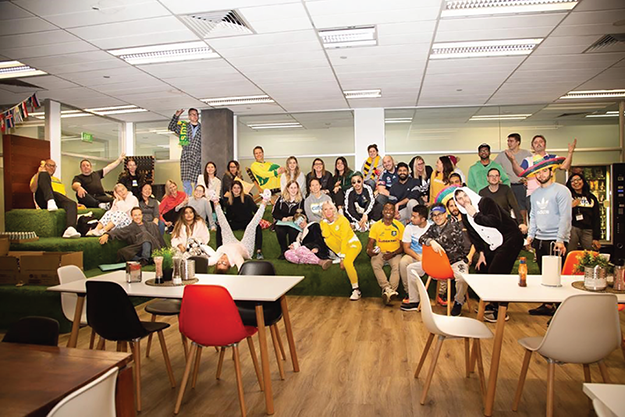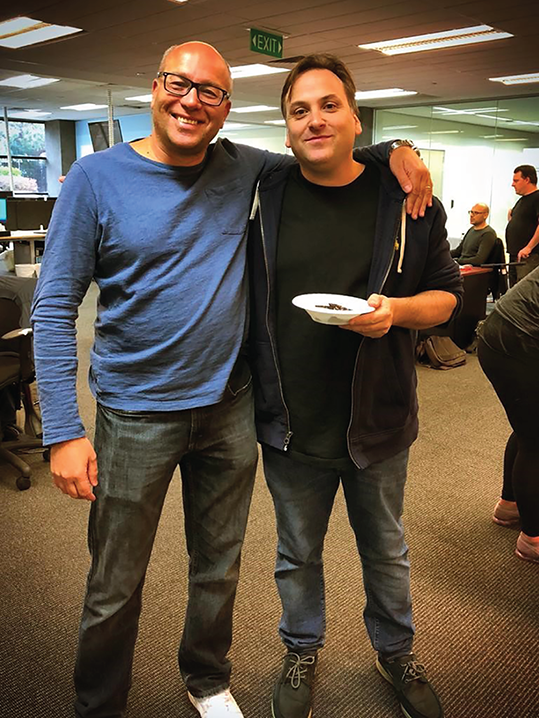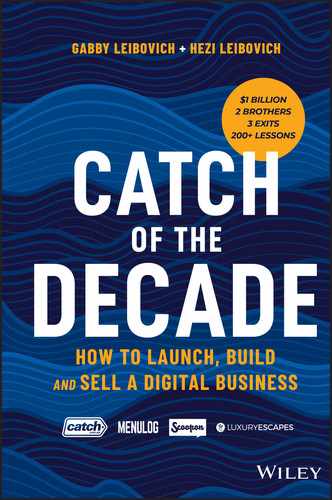CHAPTER 10
The Catch culture
We've never understood why employees who leave the corporate sector to set up their own business often drag with them the exact culture they were trying to escape. Why would you take so much risk and invest so much time and energy only to recreate the same bullshit atmosphere that you hated in the first place? Most of us spend more than one‐third of our lives at work (maybe more!) so it makes sense to create a workplace culture that excites you and your team.
By mid 2013, it was obvious that we were successful in creating a place where people wanted to work—maybe too successful, as we now had 400 people crammed into three sites around the suburbs of Melbourne. To say this wasn't ideal was an understatement, and the problem wasn't going to go away. We were still hiring like crazy and we had nowhere for them to sit! The workplaces were bursting at the seams.
The fact our office and warehouse locations were not located in the hipster suburbs of Richmond and South Melbourne—where the millennial technerati prefer to work from—said volumes about our culture. Despite our daggy suburban locations, we attracted the best and the brightest from around the country and they didn't mind working far from the epicentres of disruption because they loved working for us. So, as we looked for a new home for all of our businesses under one roof, we were fortunate that we didn't feel the need to move to one of those expensive innovation hubs. We could go where we had space to grow.
Sliding into greatness
We toured the recently vacated former headquarters of Adidas Australia in the south‐eastern suburb of Mulgrave. While the rent was three times more than what we'd ever paid, it was love at first sight. The massive 5000 m2 space was spread over two floors and had plenty of room for all of our businesses. Adidas was kind enough to leave us a working gym and, outside, a basketball court and beautiful garden. Good luck finding that in the CBD.
All the furniture was still intact, too, from the deck chairs to the boardroom conference table. All we had to do was walk in, plug in and start working. And Adidas left behind one more thing that really sealed the deal, the slogan that greeted everyone at the door: ‘Impossible is Nothing’.
It still seems impossible that we agreed to management's request to spend more than one million dollars in rent per year for that space, but what can we say? We were on a high. We felt invincible at that stage on our journey. Nothing seemed impossible. It didn't stop there. We ended up installing a slide so staff members could slide from the upper floor to the ground floor. Now, we admit, not many people took the slide. It was a bumpy, twisty ride, and God help you if you tried it with a cup of coffee in your hand. But every person who walked in the door, whether it was a new supplier or a prospective employee or the postman, must have told their friends about this crazy office with a slide because it was the first thing people wanted to see when they visited the building.
Our Mulgrave headquarters quickly became notorious in the start‐up community. The new building was also a major drawcard for our HR department. Talented people who had never even heard of Mulgrave before would come for an interview, have their heads turned by the atmosphere, and be on staff and in the thick of things before they knew what had happened. Most importantly, every reporter who ever stopped by included the slide in their story. It paid for itself in free PR alone.
Interestingly, our office on Springvale Rd, Mulgrave, was exactly opposite the head office of Kmart Australia. We watched them every day, and we are certain that they looked at us. Quite often many of us would cross the road to eat lunch and grab a coffee from the Kmart cafeteria, which was open to the many offices in the area. Who would have known that five years later our companies would merge?
Why not make it fun?
Where would you rather work: a fun place or a dud place? How would you rather your employees feel in the morning: psyched up and excited about getting to work, or dreading it and dreaming of all the places they'd rather be? How would you rather your employees feel in the evening: happy to stay a bit longer to get the job done, or watching the clock until it hits 5 pm and rushing out the door?
Who would you rather hire: someone who could get a job anywhere but really wants to be part of your team, or someone with no other prospects because the top talent all went somewhere else?
The answers are obvious. So, it's obvious why you should invest some time into making your office a fun place to be.
Fortunately, it doesn't have to be expensive. Not everyone can have a gym or a slide in their head office, but you don't need them to create a fun, friendly workplace. It's amazing how far a Friday barbecue or a dress‐up day can go in breaking down barriers, loosening people up and making friendships.
If people have friends at work, they'll be excited to come to the office.
It felt good for us to see 10 IT guys taking a walk every afternoon, the customer service teams playing basketball and the buyers having massive birthday lunches. That's how we knew our teams were strong: they spent time together when they didn't have to.
Besides, it's not just better for your staff to have fun at work. It's better for you. You'll spend most of your time at work. Make sure it's fun.
Negotiating in pyjamas
This fun spirit can have a powerful impact on your brand in other ways, too. One day, we had senior executives from Australia Post coming in to discuss a major deal. We were spending eight figures with them, so it was an important meeting.
It just so happened that we had a staff dress‐up day scheduled, where everyone—management included—committed to showing up in pyjamas, irrespective of what meetings we had on or who was visiting. The Australia Post executives were sitting on one side of the boardroom in their three‐piece suits and shiny shoes, when in we walked, clad in our Bob the Builder and Dora the Explorer sleepwear.
For a start, the looks on their faces were priceless. But second, it broke the ice and created lots of laughs before we got down to the serious business of negotiating pricing.

Our in‐house café was the heart of Catch. It's where parties, celebrations and all major announcements took place.
Events like this create an impression that doing business with Catch is a positive experience. They go back to their office saying,
‘How crazy are those Catch guys? We just had a meeting and they were all dressed in pyjamas! They're insane!’
If ‘brand’ is what people say about you when you're out of the room, we were pretty sure people were saying Catch looked like a fun place to work. Our reputation for creating a happy workplace created a powerful word‐of‐mouth effect that made hiring new employees a piece of cake. (Which, by the way, we ate a lot of at Catch. Never let a birthday go to waste!)
We rarely advertised because as soon as we had an opening, our staff would put the word out to their personal networks and do the recruitment for us. Later on, we did spend more than $600 000 one year on recruitment fees to hire new staff, so take it from us: it's much cheaper and faster to hire from internal recommendations. And the results are just as good, maybe better, because your culture is your people.
Your culture is your people
Our philosophy has always been, ‘hire for attitude, train for skill’. You can teach skills. You can't teach attitude. After hiring more than 2000 people, we know a thing or two about who makes a great team player and who doesn't.
Someone who's curious, energetic, involved, puts the team first and always looks for a way to get things done: these people would always find a place at Catch. Get enough of them together, working every day for the same goal, and you create a company that can do anything. You get a happy company and happy people.

Gabby and Hezi in the office celebrating a team member's birthday. Never let a good birthday go to waste!
Happy people are more effective, happy people create solutions, happy people share ideas and speak up, happy people engage in change and allow for innovation to take place.
It has to be said: we had a happy workplace!
On the other hand, get enough people together who are lazy, or self‐centred, or toxic (more on that later), and it doesn't matter what big companies are on their résumé, or how many programming languages they know: no amount of training can alter their attitude. They'll take the company down with them.
Be a mensch
Of course, as leaders we have to set the example. If you're the boss, be a mensch. That's Yiddish for a nice guy. If leaders behave with integrity and respect, their teams will do the same. If leaders behave poorly, then it sets the standards for everyone else to behave poorly. Some say ‘nice guys finish last’, but we don't agree. It's no fun being nasty. We much prefer the carrot to the stick, and besides, the ‘don't be a jerk’ approach yields better results.
As an entrepreneur, being a mensch also means giving as much, or more, to the company as you ask of your employees. If you're not doing your part, your staff will notice and adjust their own efforts accordingly. Can you blame them? For example, if you need your employees to stay late, you can't clock off in time to go home and watch the 6 pm news. If that's what you want out of life, working in a start‐up is probably not for you.
If you need honest advice (and you do), you can't get angry when people tell you some truths you don't want to hear, or ask inconvenient questions. Everyone should be encouraged to challenge everyone else, or your business will suffer from small head mentality. If you can't handle challenges from within your team, you're not ready to handle the challenges from your competitors.
If you need people to watch your back, you have to watch theirs. A little kindness and flexibility can work wonders in helping you build a loyal family around you. The truth is, you will probably spend more time with these people than with your own family. Loyalty is a two‐way street.
And you have to be the first to get stuck in. We were always at work, always ready to be involved in any decision, always putting our own opinions on the line. Culture is what happens when the leader isn't looking. The more staff members see their leaders doing the right thing, working as hard as anyone, the sooner they will understand what the company needs and follow that lead, even when the boss is on holiday.
Ready for something mind‐blowing? Being nice extends to your competitors, too. Even when it seems counter‐intuitive to be nice, it's the right thing to do, and believe it or not, it pays off. When launching our new state‐of‐the‐art warehouse, we invited 200 of our A‐grade suppliers, and even the CEOs of competitive companies, to take a tour and see our amazing robots in action. Our automation process was the talk of the town and everyone wanted to see what we were doing. We were very open to sharing our trade secrets with our competitors. Everyone asked, ‘Why would you do that?’ We saw it as our responsibility to help educate the industry overall, and to create a sense of goodwill and camaraderie with everyone in the sector. Besides, it took us three years to build this warehouse, so if anyone wanted to go and ‘copy’ us, then so be it; it would take them three years to do the same.
And here's the kicker: a week later, five of those A‐grade visitors signed up their premium brands to become Catch suppliers. We call that the karmic reaction. Make no mistake: if you're a jerk, word will travel fast and no‐one will want to work with you, or for your business. If you're a mensch, word will also get around, and you'll have everyone lining up to work with you. Why not take the latter route? Not only is it good for business, but you get to sleep well at night too.
AIRheads need not apply
AIR stands for ‘Arsehole In the Room’. You know the type: always dismissive of other opinions, making decisions that put their needs first, trying to stand out by bullying and putting others down. The AIRhead always takes credit for positive results, and never takes responsibility for negative ones.
Diagnosing the condition is difficult because the carriers are often very smart and good at their job. Their co‐workers may consider them indispensable. This gives the arseholes more power and freedom to be even more destructive. Other employees see this behaviour being not just tolerated, but rewarded. The company descends into a toxic cesspool of chaos and conflict that can be difficult, if not impossible, to pull out of.
We've encountered AIRheads in every department, but mostly in the C‐suite. You can move them around, you can read them the riot act, but it will be about as useful as moving the deck chairs on the Titanic. If someone on your team is displaying these symptoms, get rid of them. Permanently. Quickly. Today. Or your best team players will find somewhere less toxic to work, and you'll be left with nothing but AIRheads.
